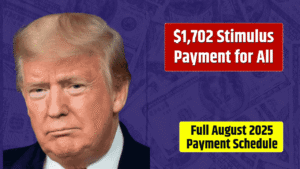For millions of Americans, the monthly budget has started to feel like a game of financial Jenga—one wrong move, and the whole thing topples. Groceries that used to cost $50 now push $70, rents that were already steep keep climbing, and don’t even get started on medical bills. Against this backdrop, the idea of a fourth federal stimulus check—this time for $2,000—has found its way back into serious political conversation as of June 2025. Supporters frame it as a lifeline for working families; critics warn it could fan the flames of inflation. Either way, the debate is heating up almost as fast as the summer air.
No bill has been signed, no Treasury trucks are loading up debit cards just yet. But the momentum is real. Lawmakers from both sides are floating the idea again, and advocacy groups are making a lot of noise. The pitch is simple: direct payments that put cash in the hands of consumers fast, to help them cope with inflation and give the economy a quick shot in the arm.
Table of Contents
Why the Fourth Stimulus Check is Back in the Spotlight
The official inflation rate has eased a little from its 2022 highs, but that’s cold comfort when your grocery bill is up 15% year-over-year. Prices for food, housing, transportation, and healthcare have all stubbornly refused to go back to pre-pandemic levels. And while wages have inched up, they haven’t kept pace.
Seniors, disabled Americans, and those living on Social Security, SSDI, or SSI have been particularly vocal. Yes, the 2025 cost-of-living adjustment (COLA) added a bit to monthly checks, but according to the Bureau of Labor Statistics, real purchasing power for fixed-income households is still slipping. Several advocacy groups have urged Congress to authorize a one-time $2,000 payment to help people keep up.
There’s also a business angle here. Retail sales and small business activity have shown signs of softening in the last two quarters, according to U.S. Census Bureau data. Direct stimulus payments are seen as a way to stimulate demand quickly—money that typically gets spent on necessities rather than sitting in savings.
Who Could Qualify if it Passes
While nothing’s official yet, eligibility rules would likely look a lot like the earlier rounds in 2020 and 2021. The IRS would handle distribution again, using tax return or benefits data. Based on past precedent, here’s the probable outline:
| Category | Likely Eligibility Criteria |
|---|---|
| Individuals | Adjusted gross income (AGI) up to $75,000 |
| Heads of Household | AGI up to $112,500 |
| Married Couples | AGI up to $150,000 |
| Dependents | Additional payment per child or qualifying dependent |
| Non-Filers | Could qualify if receiving Social Security, SSDI, SSI, VA benefits, or certain other federal payments |
People receiving Social Security or disability benefits would almost certainly be included, just as they were in previous stimulus rounds. The IRS has systems in place to reach those recipients without requiring new applications.
How Soon Could It Happen?
That’s the frustrating part—there’s no clear timeline. Even if the proposal gains traction in the fall 2025 legislative session, it could take months to negotiate, pass, and implement. Historically, once signed into law, the first payments went out within two to six weeks. Given current political gridlock, late 2025 or early 2026 would be the most optimistic projection.
It’s worth noting: if Congress can’t agree on a broad check, they might pivot to targeted relief programs like an expanded Child Tax Credit, enhanced SNAP benefits, or temporary boosts to Social Security payments.
Other Support That Might Be Available
If you’re not holding your breath for a check, there are still other forms of help that could see expansion in 2025:
- SNAP (food stamps) — Monthly benefits that adjust with inflation.
- LIHEAP — Energy bill assistance for low-income households.
- Rental assistance programs — Available in some states through local agencies.
- State-level rebates — Several states still offer their own relief payments, which may be more likely in the short term than a federal check.
You can track available programs through Benefits.gov or your state’s Department of Human Services.
Fact Check: Is a Fourth Stimulus Check Confirmed?
No—it’s still a proposal. As of mid-August 2025, no law has been passed authorizing a $2,000 federal stimulus payment. While the idea has political momentum and public support, especially among seniors and low-income households, it remains in discussion. Any website or social media post claiming “$2,000 checks are already approved” is misleading unless it cites an official press release from the U.S. Treasury or IRS.
FAQs
Is the $2,000 stimulus check guaranteed?
No, it’s only being discussed in Congress—no approval yet.
Will Social Security recipients get it if passed?
Most likely yes, based on past stimulus rules.
How much would dependents get?
Proposals suggest an additional amount per qualifying child or dependent, but numbers aren’t finalized.
Could it arrive before the 2025 holidays?
That’s possible but unlikely unless Congress acts quickly.
Are there other ways to get help now?
Yes—programs like SNAP, LIHEAP, and state rebates are available depending on your income and location.










